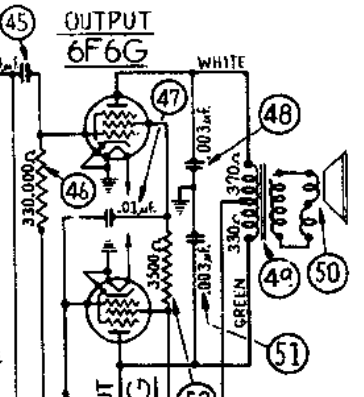Posts: 62
Threads: 20
Joined: Apr 2015
City: Decatur Alabama
I have agreed to restore a Philco 37-650 console for an acquaintance and the first thing I checked was the speaker. Of course the output transformer is open. This is an 8 tube chassis with 6f6 push/pull configuration. I told him I'm pretty sure Hammond will have what he needs but what exactly DOES he need? Anybody know the specs of this particular transformer? Thanks folks.
Posts: 7,303
Threads: 269
Joined: Dec 2009
City: Roslyn Pa
If you go down to downloadable files and click on spk zip you'll a listing of all Philco speakers pre 1937 and their specs.
Your set uses the H-13 so the voice coil/ output transformer secondary needs to be about 1 1/4 ohms. The plate load
is 5.9k.
Do note that when pentode tubes are connected in a triode configuration (plate and screen grid tied together) the plate load is much lower. Typically 6F6'sin penode mode will be about 12K.
When my pals were reading comic books
I was down in the basement in my dad's
workshop. Perusing his Sam's Photofoacts
Vol 1-50 admiring the old set and trying to
figure out what all those squiggly meant.
Circa 1966
Now I think I've got!
Terry
(This post was last modified: 03-10-2024, 06:00 PM by
Radioroslyn.)
Posts: 62
Threads: 20
Joined: Apr 2015
City: Decatur Alabama
Posts: 1,151
Threads: 47
Joined: Feb 2015
City: Roseville, MN
Before you install that replacement transformer be sure to fix the power supply. It seems this chassis has a reputation for taking out OPTs. I have three 650 chassis from 1936 (same circuit but with pp 42s) and all three have open OPT and interstage transformer primaries.
Posts: 62
Threads: 20
Joined: Apr 2015
City: Decatur Alabama
Wow. I haven't even checked anything else yet, interstage or power transformer. Those I have replacements for. But what is it that takes out the OP xfmr? And while I have your ear, what specific OP transformer do you use for a replacement?
Posts: 1,151
Threads: 47
Joined: Feb 2015
City: Roseville, MN
When the filter capacitors don't filter any more, then B+ can reach 400+ volts. The increase in plate voltage causes higher than normal plate current which also flows through the transformer primary, poof!
The Hammond 125D was my target. It's a universal 10 watt and accommodates the low H13 speaker impedance. I ended up getting an OPT from a Philco speaker at a garage sale. BTW don't get the one on ePay for $40. The seller is foreign and has no control over his US inventory. Read his feedback.
Posts: 714
Threads: 9
Joined: Apr 2018
City: S. Dartmouth
State, Province, Country: MA
Go here to determine the output transformer:
http://www.radioremembered.org/outimp.htm

Caps #48 & #51 should be replaced with a type that has a known Dv/Dt rating. When static is received by the radio, the plate current is abruptly cutoff. That causes a collapse in the magnetic field of the OPT and a high voltage pulse appears across the windings. That pulse can puncture the paper layers and arc. The transformer may not open on the first "hit" but acids are created that eat away at the copper until the winding goes open. Avoid the common metalized cap without a rating as these cannot withstand a pulse, it is NOT that the film will puncture, it is the metallizing, so thin it separates and looses capacity, therefore the cap can no longer protect the transformer. These same cap(s) provide a filter for high frequencies, part of the tone... Increasing the voltage rating will not help, as it is the metalizing is too thin. A cap designed for pulse service has thicker metalizing. Use the same voltage value as the OEM paper cap...
The OEM speaker has a hum buck coil in addition to the voice coil, that should bring the impedance up for a modern output transformer. It is BEST to re-cone such a speaker. It is tedious but not difficult.
The 6F6 is notorious for grid poisoning, if either of the output tubes has this problem plate current with dramatically increase and the plate may blush, punishing the OPT... Do be sure all the components in the passive phase converter are correct, that too can effect the 6F6's as WILL the grid voltage.
GL
Chas
Pliny the younger
“nihil novum nihil varium nihil quod non semel spectasse sufficiat”
Posts: 62
Threads: 20
Joined: Apr 2015
City: Decatur Alabama
Good lord, I'm in a Philco encyclopaedia! Thanks, guys. I have some Philcos I collected over the years but never tore into them. Zeniths are my usual choice. But I might have to get that 37-116 up and running now! Great help!



![[-] [-]](https://philcoradio.com/phorum/images/bootbb/collapse.png)


